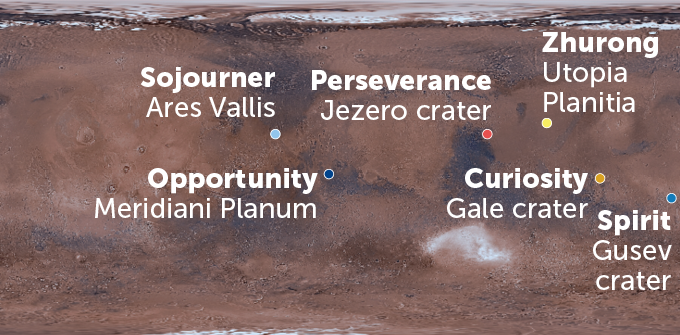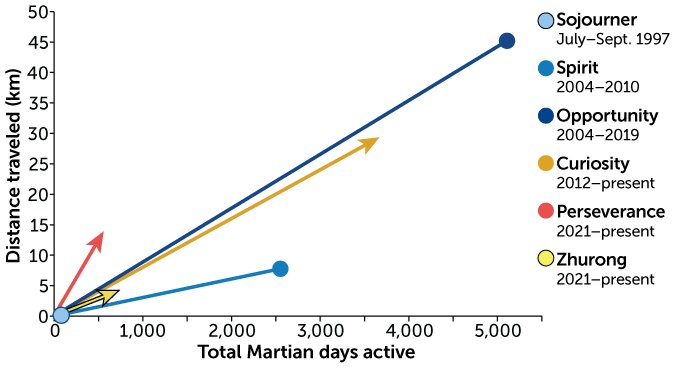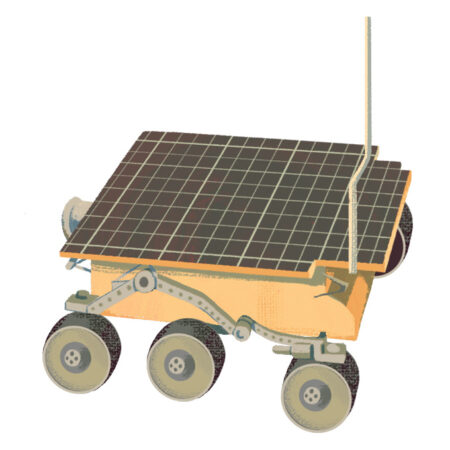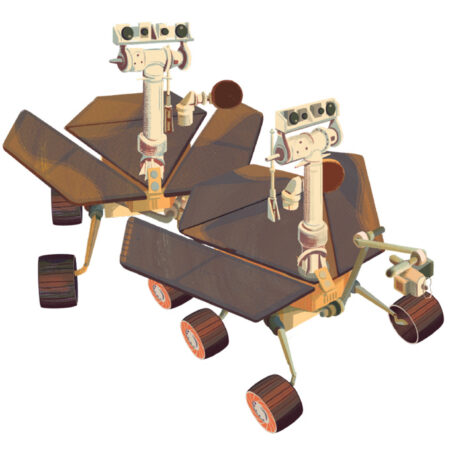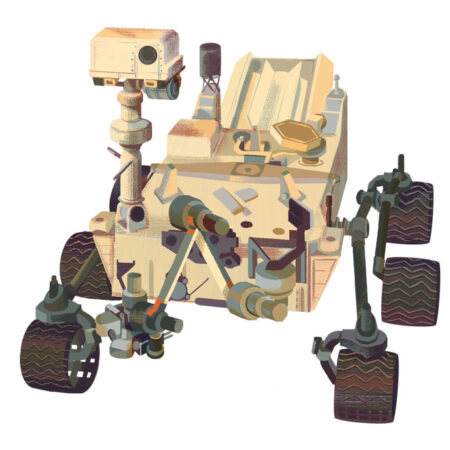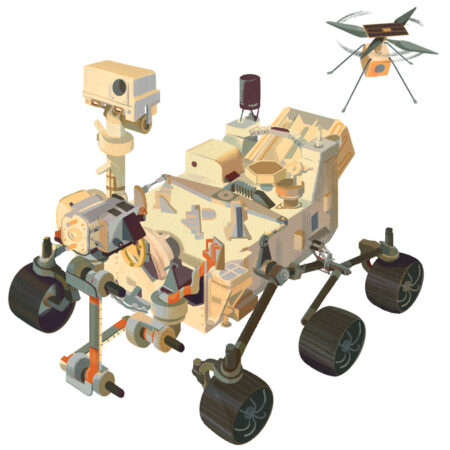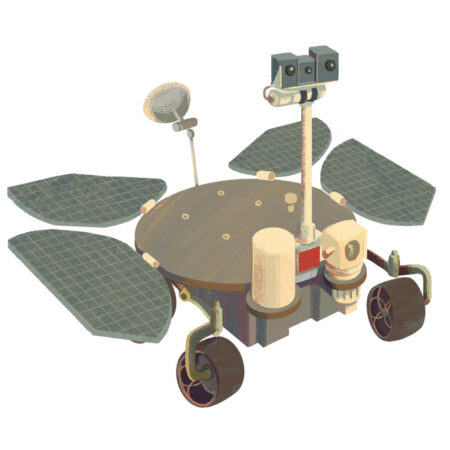This post was originally published on this site
Few things are harder than hurling a robot into space — and sticking the landing. On the morning of July 4, 1997, mission controllers at the Jet Propulsion Laboratory in Pasadena, Calif., were hoping to beat the odds and land a spacecraft successfully on the Red Planet.
Twenty-five years ago that little robot, a six-wheeled rover named Sojourner, made it — becoming the first in a string of rovers built and operated by NASA to explore Mars. Four more NASA rovers, each more capable and complex than the last, have surveyed the Red Planet. The one named Curiosity marked its 10th year of cruising around on August 5. Another, named Perseverance, is busy collecting rocks that future robots are supposed to retrieve and bring back to Earth. China recently got into the Mars exploring game, landing its own rover, Zhurong, last year.
Other Mars spacecraft have done amazing science from a standstill, such as the twin Viking landers in the 1970s that were the first to photograph the Martian surface up close and the InSight probe that has been listening for Marsquakes shaking the planet’s innards (SN Online: 2/24/20). But the ability to rove turns a robot into an interplanetary field geologist, able to explore the landscape and piece together clues to its history. Mobility, says Kirsten Siebach, a planetary scientist at Rice University in Houston, “makes it a journey of discovery.”
Each of the Mars rovers has gone to a different place on the planet, enabling scientists to build a broad understanding of how Mars evolved over time. The rovers revealed that Mars contained water, and other life-friendly conditions, for much of its history. That work set the stage for Perseverance’s ongoing hunt for signs of ancient life on Mars.
Each rover is also a reflection of the humans who designed and built and drove it. Perseverance carries on one of its wheels a symbol of Mars rover tracks twisted into the double helix shape of DNA. That’s “to remind us, whatever this rover is, it’s of human origin,” says Jennifer Trosper, an engineer at the Jet Propulsion Lab, or JPL, who has worked on all five NASA rovers. “It is us on Mars, and kind of our creation.”
The little microwave that could
Sojourner, that first rover, was born in an era when engineers weren’t sure if they even could get a robot to work on Mars. In the early 1990s, then-NASA Administrator Daniel Goldin was pushing the agency to do things “faster, better and cheaper” — a catchphrase that engineers would mock by saying only two of those three things were possible at the same time. NASA had no experience with interplanetary rovers. Only the Soviet Union had operated rovers — on the moon in 1970 and 1973.
JPL began developing a Mars rover anyway. Named after the abolitionist Sojourner Truth, the basic machine was the size of a microwave oven. Engineers were limited in where they could send it; they needed a large flat region on Mars because handling a precision landing near mountains or canyons was beyond their abilities. NASA chose Ares Vallis, a broad outflow channel from an ancient flood, and the mission landed there successfully.
Sojourner spent nearly three months poking around the landscape. It was slow going. Mission controllers had to communicate with Sojourner constantly, telling it where to roll and then assessing whether it had gotten there safely. They made mistakes: One time they uploaded a sequence of computer commands that mistakenly told the rover to shut itself down. They recovered from that stumble and many others, learning to quickly fix problems and move forward.

Although Sojourner was a test mission to show that a rover could work, it managed to do some science with its one X-ray spectrometer. The little machine analyzed the chemical makeup of 15 Martian rocks and tested the friction of the Martian soil.
After surviving 11 weeks beyond its planned one-week lifetime, Sojourner ultimately grew too cold to operate. Trosper was in mission control when the rover died on September 27, 1997. “You build these things, and even if they’re well beyond their lifetime, you just can’t let go very easily, because they’re part of you,” she says.

Twin explorers
In 1998 and 1999, NASA hurled a pair of spacecraft at Mars; one was supposed to orbit the planet and another was supposed to land near one of the poles. Both failed. Stung from the disappointment, NASA decided to build a rover plus a backup for its next attempt.
Thus were born the twins Spirit and Opportunity. Each the size of a golf cart, they were a major step up from Sojourner. Each had a robotic arm, a crucial development in rover evolution that enabled the machines to do increasingly sophisticated science. The two had beefed-up cameras, three spectrometers and a tool that could grind into rocks to reveal the texture beneath the surface.
But there were a lot of bugs to work out. Spirit and Opportunity launched several weeks apart in 2003. Spirit got to Mars first, and on its 18th Martian day on the surface it froze up and started sending error messages. It took mission controllers days to sort out the problem — an overloaded flash-memory system — all while Opportunity was barreling toward Mars. Ultimately, engineers fixed the problem, and Opportunity landed safely on the opposite side of the planet from Spirit.
Both rovers lasted years beyond their expected three-month lifetimes. And both did far more Martian science than anticipated.
Spirit broke one of its wheels early on and had to drive backward, dragging the broken wheel behind it. But the rover found plenty to do near its landing site of Gusev crater, home to a classic Mars landscape of dust, rock and hills. Spirit found rocks that appeared to have been altered by water long ago and later spotted a pair of iron-rich meteorites. The rover ultimately perished in 2010, stuck in a sand-filled pit. Mission controllers tried to extract it in an effort dubbed “Free Spirit,” but salts had precipitated around the sand grains, making them particularly slippery.
Opportunity, in contrast, became the Energizer Bunny of rovers, exploring constantly and refusing to die. Immediately after landing in Meridiani Planum, Opportunity had scientists abuzz.

JPL-CALTECH/NASA, CORNELL UNIV., ARIZONA STATE UNIV.
“The images that the rover first sent back were just so different from any other images we’d seen of the Martian surface,” says Abigail Fraeman, a planetary scientist at JPL. “Instead of these really dusty volcanic plains, there was just this dark sand and this really bright bedrock. And that was just so captivating and inspiring.”
Right at its landing site, Opportunity spotted the first definitive evidence of past liquid water on Mars, a much-anticipated and huge discovery (SN: 3/27/04, p. 195). The rover went on to find evidence of liquid water at different times in the Martian past. After years of driving, the rover reached a crater called Endeavour and “stepped into a totally new world,” Fraeman says. The rocks at Endeavour were hundreds of millions of years older than others studied on Mars. They contained evidence of different types of ancient water chemistry.
Opportunity ultimately drove farther than any rover on any extraterrestrial world, breaking a Soviet rover’s lunar record. In 2015, Opportunity passed 26.2 miles (42.2 km) on its odometer; mission controllers celebrated by putting a marathon medal onto a mock-up of the rover and driving it through a finish line ribbon at JPL. Opportunity finally died in 2019 after an intense dust storm obscured the sun, cutting off solar power, a must-have for the rover to recharge its batteries (SN: 3/16/19, p. 7).
The twin rovers were a huge advance over Sojourner. But the next rover was an entirely different beast.

The SUV of rovers
By the mid-2000s, NASA had decided it needed to go big on Mars, with a megarover the size of a sports utility vehicle. The one-ton Curiosity was so heavy that its engineers had to come up with an entirely new way to land on Mars. The “sky crane” system used retro-rockets to hover above the Martian surface and slowly lower the rover to the ground.
Against all odds, in August 2012, Curiosity landed safely near Mount Sharp, a 5-kilometer-high pile of sediment within the 154-kilometer-wide Gale crater (SN: 8/25/12, p. 5). Unlike the first three Mars rovers, which were solar-powered, Curiosity runs on energy produced by the radioactive decay of plutonium. That allows the rover to travel farther and faster, and to power a suite of sophisticated science instruments, including two chemical laboratories.
Curiosity introduced a new way of exploring Mars. When the rover arrives in a new area, it looks around with its cameras, then zaps interesting rocks with its laser to identify which ones are worth a closer look. Once up close, the rover stretches out its robotic arm and does science, including drilling into rocks to see what they are made of.
When Curiosity arrived near the base of Mount Sharp, it immediately spotted rounded pebbles shaped by a once-flowing river, the first closeup look at an ancient river on Mars. Then mission controllers sent the rover rolling away from the mountain, toward an area in the crater known as Yellowknife Bay. There Curiosity discovered evidence of an ancient lake that created life-friendly conditions for potentially many thousands of years.
Curiosity then headed back toward the foothills of Mount Sharp. Along the way, the rover discovered a range of organic molecules in many different rocks, hinting at environments that had been habitable for millions to tens of millions of years. It sniffed methane gas sporadically wafting within Gale crater, a still-unexplained mystery that could result from geologic reactions, though methane on Earth can be formed by living organisms (SN: 7/7/18, p. 8). The rover measured radiation levels across the surface — helpful for future astronauts who’ll need to gauge their exposure — and observed dust devils, clouds and eclipses in the Martian atmosphere and night sky.

MSSS, JPL-Caltech/NASA
“We’ve encountered so many unexpectedly rich things,” says Ashwin Vasavada of JPL, the mission’s project scientist. “I’m just glad a place like this existed.”
Ten years into its mission, Curiosity still trundles on, making new discoveries as it climbs the foothills of Mount Sharp. It recently departed a clay-rich environment and is now entering one that is heavier in sulfates, a transition that may reflect a major shift in the Martian climate billions of years ago.
In the course of driving more than 28 kilometers, Curiosity has weathered major glitches, including one that shuttered its drilling system for over a year. And its wheels have been banged up more than earthbound tests had predicted. The rover will continue to roll until some unknown failure kills it or its plutonium power wanes, perhaps five years from now.

MSSS, JPL-Caltech/NASA
A rover and its sidekick
NASA’s first four rovers set the stage for the most capable and agile rover ever to visit Mars: Perseverance. Trosper likens the evolution of the machines to the growth of children. “We have a preschooler in Sojourner, and then … your happy-go-lucky teenagers in Spirit and Opportunity,” she says. “Curiosity is certainly a young adult that’s able to do a lot of things on her own, and Perseverance is kind of that high-powered midcareer [person] able to do pretty much anything you ask with really no questions.”
Perseverance is basically a copy of Curiosity built from its spare parts, but with one major modification: a system for drilling, collecting and storing slender cores of rock. Perseverance’s job is to collect samples of Martian rock for future missions to bring to Earth, in what would be the first robotic sample return from Mars. That would allow scientists to do sophisticated analyses of Martian rocks in their earthbound labs. “It feels, even more than previous missions, that we are doing this for the next generation,” Siebach says.
The rover is working fast. Compared with Curiosity’s leisurely exploration of Gale crater, Perseverance has been zooming around its landing site, the 45-kilometer-wide Jezero crater, since its February 2021 arrival. It has collected 10 rock cores and is already eyeing where to put them down on the surface for future missions to pick up. “We’re going to bring samples back from a diversity of locations,” says mission project scientist Kenneth Farley of Caltech. “And so we keep to a schedule.”
Perseverance went to Jezero to study an ancient river delta, which contains layers of sediment that may harbor evidence of ancient Martian life. But the rover slightly missed its target, landing on the other side of a set of impassable sand dunes. So it spent most of its first year exploring the crater floor, which turned out to be made of igneous rocks (SN: 9/11/21, p. 32). The rocks had cooled from molten magma and were not the sedimentary rocks that many had expected.
Scientists back on Earth will be able to precisely date the age of the igneous rocks, based on the radioactive decay of chemical elements within them, providing the first direct evidence for the age of rocks from a particular place on Mars.

JPL-CALTECH/NASA, ARIZONA STATE UNIV.
Once it finished exploring the crater floor in March, the rover drove quickly toward the delta. Each successive NASA rover has had greater skills in autonomous driving, able to identify hazards, steer around them and keep going without needing constant instructions from mission control.
Perseverance has a separate computer processor to run calculations for autonomous navigation, allowing it to move faster than Curiosity. (It took Curiosity two and a half years to travel 10 kilometers; Perseverance traveled that far in a little over a year.) “The rover drives pretty much every minute that we can give it,” Farley says.
In April, Perseverance set a Martian driving record, traveling nearly five kilometers in just 30 Martian days. If all goes well, it will make some trips up and down the delta, then travel to Jezero crater’s rim and out onto the ancient plains beyond.
Perseverance has a sidekick, Ingenuity, the first helicopter to visit another world. The nimble flier, only half a meter tall, succeeded beyond its designers’ wildest dreams. The helicopter made 29 flights in its first 16 months when it was only supposed to make five in one month. It has scouted paths ahead and scientific targets for the rover (SN Online: 4/19/22). Future rovers are almost certain to carry a little buddy like this.

China’s debut
While the United States has led in Mars rover exploration, it is not the only player on the scene. In May 2021, China became the second nation to successfully place a rover on Mars. Its Zhurong rover, named after a mythological fire god, has been exploring part of a large basin in the planet’s northern hemisphere known as Utopia Planitia.
The landing site lies near a geologic boundary that may be an ancient Martian shoreline. Compared with the other Mars rover locations, Zhurong’s landing site is billions of years younger, “so we are investigating a different world on Mars,” says Lu Pan, a planetary scientist at the University of Copenhagen who has collaborated with Zhurong scientists.
In many ways, Zhurong resembles Spirit and Opportunity, in size as well as mobility. It carries cameras, a laser spectrometer for studying rocks and ground-penetrating radar to probe underground soil structures (SN Online: 5/19/21).
After landing, Zhurong snapped pictures of its rock-strewn surroundings and headed south to explore a variety of geologic terrains, including mysterious cones that could be mud volcanoes and ridges that look like windblown dunes. The rover’s initial findings include that the Martian soil at Utopia Planitia is similar to some desert sands on Earth and that water had been present there perhaps as recently as 700 million years ago.
In May, mission controllers switched Zhurong into dormant mode for the Martian winter and hope it wakes up at the end of the season, in December. It has already traveled nearly two kilometers across the surface, farther than the meager 100 meters that Sojourner managed. (To be fair, Sojourner had to keep circling its lander because it relied on that lander to communicate with Earth.)

From Sojourner to Zhurong, the Mars rovers show what humankind can accomplish on another planet. Future rovers might include the European Space Agency’s ExoMars, although its 2022 launch was postponed after Russia attacked Ukraine (SN: 3/26/22, p. 6). Europe terminated all research collaborations with Russia after the invasion, including launching ExoMars on a Russian rocket.
Vasavada remembers his sense of awe at the Curiosity launch in 2011: “Standing there in Florida, watching this rocket blasting off and feeling it in your chest and knowing that there’s this incredibly fragile complex machine hurtling on the end of this rocket.… It just gave me this full impression that here we are, humans, blasting these things off into space,” he says. “We’re little tiny human beings sending these things to another planet.”
